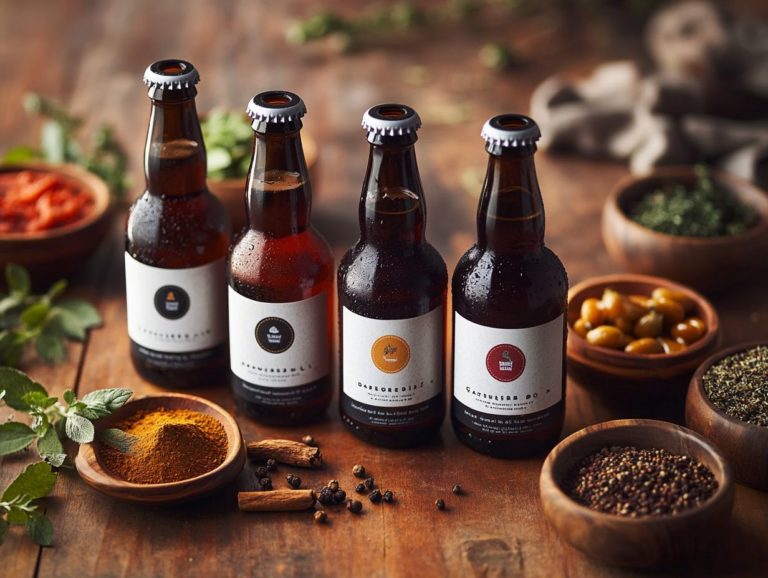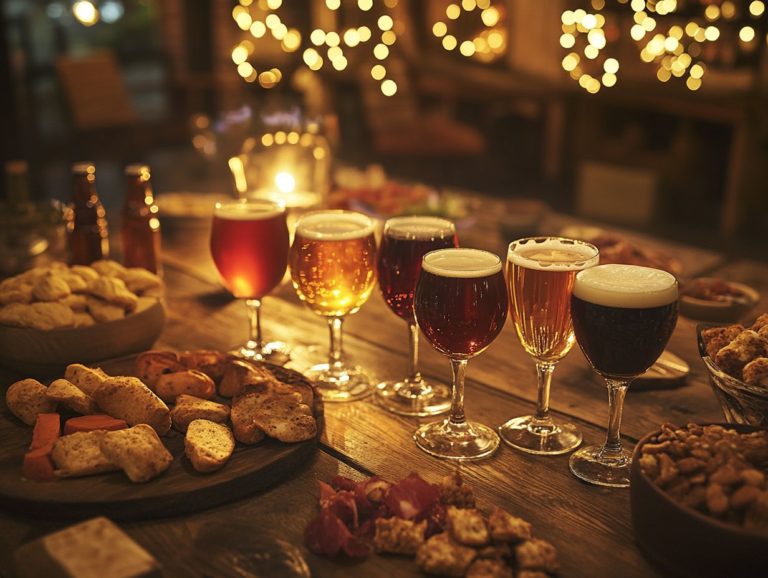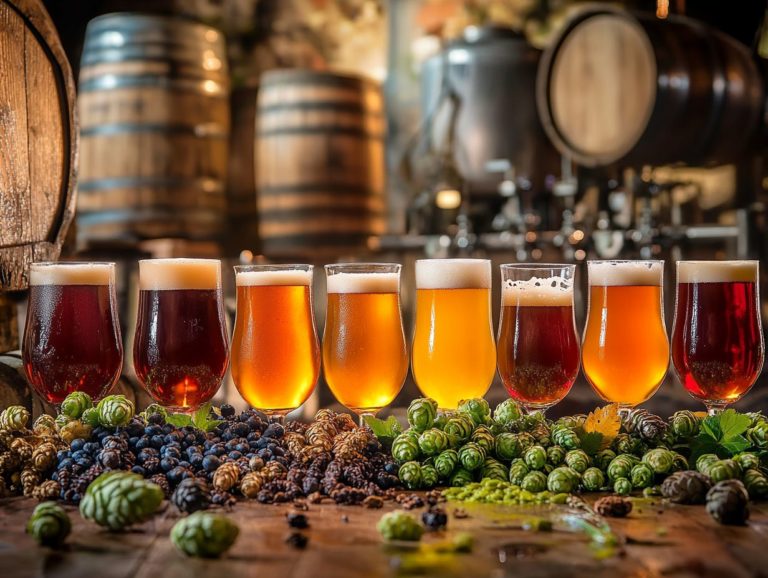7 Craft Beer Styles You Didn’t Know Existed
Contents
- Discover Lesser-Known Craft Beer Styles
- Beer Styles
- Why Are These Styles Becoming More Popular in the Craft Beer Community?
- Frequently Asked Questions
- What are the 7 craft beer styles that I didn’t know existed?
- What is Gose and how is it different from other beers?
- What is Bi re de Garde and where does it originate from?
- What makes Rauchbier stand out among other beers?
- What is Dampfbier and what does it taste like?
- What is Kvass and where is it popular?
- What makes Kolsch and Lambic different from other beer styles and trends?
- Frequently Asked Questions
Discover Lesser-Known Craft Beer Styles
Craft beer represents a vibrant universe teeming with creativity and innovation. However, some truly unique styles often go unnoticed by many beer enthusiasts. From barrel-aged beers to seasonal beers, the world of craft beer is rich with variety.
This article presents seven lesser-known craft beer styles, including Gose and Sahti. Each style boasts its own distinctive characteristics and captivating history. Explore what differentiates these brews from more traditional ones, such as American lager or Belgian-style ales. Uncover ways to elevate your tasting experience.
Embark on this flavorful journey through the rich tapestry of craft beer, and let your palate discover the extraordinary.
Key Takeaways:
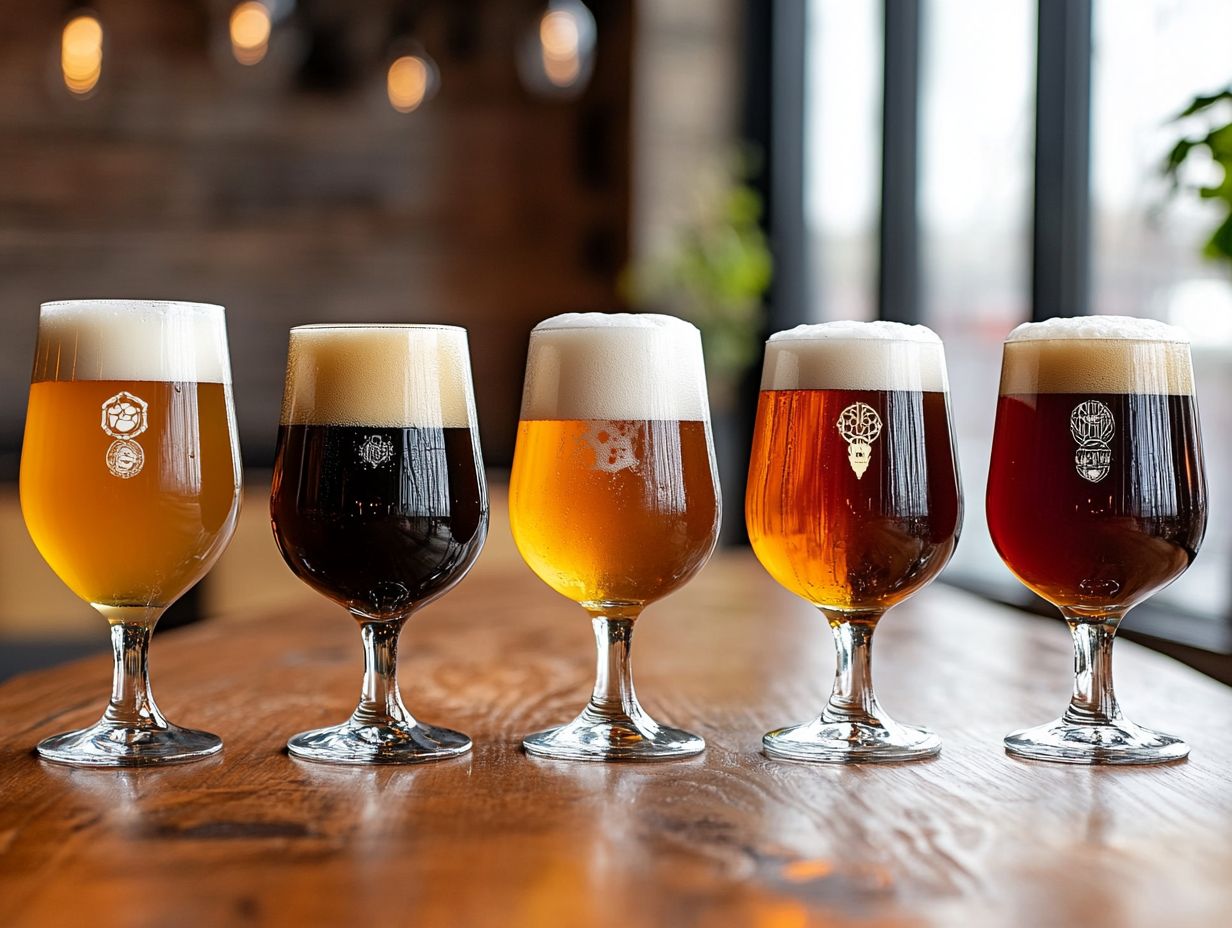
- Expand your beer palate with these 7 unique craft beer styles that you may not have heard of before, from classic beers to innovative new creations.
- From a fruity and tart Gose to a smoky Rauchbier, these styles offer a wide range of flavors and aromas to explore, perfect for any beer drinker.
- Each style has its own distinct characteristics and origins, adding depth and diversity to the world of craft beer and expanding the beer categories available to enthusiasts.
1. Gose
Gose is a captivating beer style that presents a delightful blend of flavors. It features a hint of saltiness, citrus, and spice, making it a refreshing choice for discerning craft beer enthusiasts like yourself.
This traditional German beer is often brewed with coriander and salt. It embodies the innovative spirit of the craft beer community, appealing to those who appreciate light, nuanced flavors or are eager to explore a diverse range of beer styles, including wheat beers and fruity beers.
Historically, Gose originates from the town of Goslar, Germany, with roots dating back to at least the 16th century. It has evolved over time through various brewing techniques and ingredient adaptations. The hallmark ingredients barley, wheat, hops, and the critical additions of salt and coriander come together to create its distinct tartness and body.
In today s vibrant craft beer landscape, breweries such as Westbrook Brewing and Anderson Valley have carved out a niche for themselves by crafting their own interpretations of Gose. They often incorporate unconventional adjuncts like fruit or herbs. This distinctiveness sets Gose apart from traditional beer styles, offering you a refreshing alternative that celebrates both its rich heritage and modern innovations in craft beer.
2. Bi re de Champagne
Bi re de Champagne is an exquisite style of beer that you shouldn’t miss out on. Brewed using the champagne-making method, it captures the essence of both beer and champagne through a secondary fermentation process. This adds remarkable complexity and effervescence to the drink.
This style is a shining example of the craft beer revolution, often presenting fruity aromas and rich flavors that cater to nuanced palates, similar to those found in other unique beer styles like Belgian-style Gueuze Lambic.
Unlike traditional beer, which typically ferments with a single yeast strain, Bi re de Champagne undergoes a unique dual fermentation first in the brew tank and then in the bottle enhancing its sparkling quality. This meticulous process results in a drink that often boasts a dry finish and a refined mouthfeel, reminiscent of fine sparkling wines. This exemplifies the brewing process that sets it apart from more common beer styles.
Craft breweries like Brasserie Dupont and Bosteels take center stage with their exceptional versions. They showcase a harmonious blend of hoppy notes and subtle earthiness. The marriage of these elements creates a refreshing experience that is not only satisfying but also intriguing perfect for beer enthusiasts like you who are seeking something truly distinct, similar to the experience of discovering a new IPA or American pale ale.
3. Eisbock
Eisbock is a remarkable beer style from Germany. It is made by partially freezing a Bock beer and removing the ice to concentrate its flavors and alcohol content. The result? A rich, malty brew that delights craft beer lovers. This brewing method surprises with its complexity, setting Eisbock apart from traditional styles like Amber Ale or brown ales.
Eisbock comes from the Franconian region and has deep historical roots tracing back to the early 19th century. Brewers discovered that freezing their beer could enhance its flavor. The brewing process is labor-intensive and requires skill to balance malt sweetness and alcohol strength while avoiding excessive bitterness.
When you enjoy Eisbock, expect a robust flavor profile with notes of caramel, toffee, and dark fruits perfect for those who appreciate richness in their beer. Today, breweries like Schneider Weisse and Troegs Independent Brewing have embraced Eisbock, reinforcing its place in modern beer trends. This resurgence highlights the growing interest in traditional brewing methods and unique flavors, inviting you to experience something special, alongside other rich styles like chocolate red ale and strawberry blond ale.
4. Rauchbier
Rauchbier, a traditional German beer style, is known for its unmistakable smoky flavor from malt dried over an open flame. This unique characteristic provides an engaging experience for those who appreciate the nuances of different beer profiles, similar to those in Berliner-Style Weisse.
If you’re a craft beer enthusiast, you may have noticed its increasing popularity, as local breweries add their creative twists to this classic method. The rising fame of Rauchbier shows how the craft beer revolution reshapes preferences and trends.
To craft Rauchbier, brewers select high-quality Munich and Vienna malts for a solid foundation, while smoked malt gives it that signature flavor. The balance between the sweetness of the malts and the smoke creates a spectrum of tastes, from delicate notes to bold, campfire sensations, much like the diverse profiles in stouts and porters.
Renowned craft breweries have embraced this traditional style, experimenting with different wood types and smoking techniques to create unique variations. As the craft beer landscape evolves, Rauchbier stands as a tribute to heritage brewing practices, appealing to modern drinkers eager for depth in their experience.
5. Kottbusser
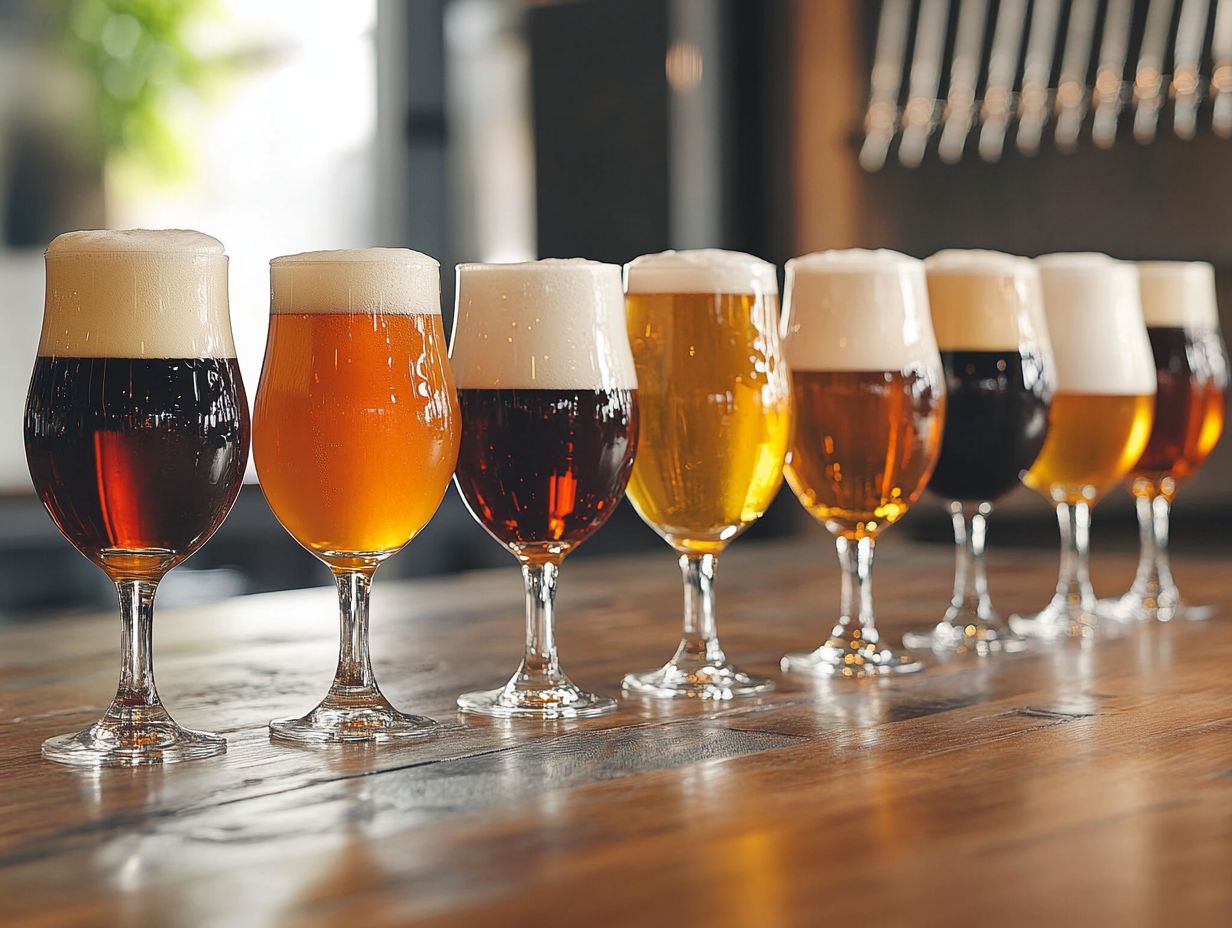
Kottbusser is an intriguing historical German beer style that invites you to enjoy a delightful blend of malt, honey, and spices, creating a sweet and complex profile that honors traditional brewing methods. As craft breweries revitalize Kottbusser, it captures the imagination of modern beer drinkers searching for unique flavors that transcend conventional styles like hoppy beers or Belgian wheat beers.
This style originates from the town of Kottbus in the former German state of Brandenburg and was popular during the 16th and 17th centuries. The brewing ingredients typically include malted barley, oats, and a unique mix of spices, including coriander, contributing to its remarkable flavor. Unlike mainstream options, Kottbusser stands out with its rich sweetness and subtle spiciness, distinguishing itself in the vibrant craft beer landscape.
Breweries like Alewks Brewing Company and Tr egs Independent Brewing have embraced this age-old recipe, showcasing its appeal and versatility. For you, the craft beer enthusiast, Kottbusser offers a fascinating look into the diverse brewing traditions of Germany and presents an exciting alternative to the modern hoppy brews that dominate the market, including popular styles like IPA and India Pale Ale.
Beer Styles
6. Sahti
Sahti is a traditional Finnish beer with captivating flavors, including juniper berries and earthy notes. It’s a perfect choice for adventurous beer drinkers seeking something truly unique.
This ancient brew is often crafted without hops and uses different types of yeast. Recently, it has gained popularity as brewers explore its rich history.
With centuries of tradition, Sahti’s recipes have been lovingly passed down through generations. Unlike modern lagers, this rustic brew adopts a spontaneous approach, resulting in varied flavors from batch to batch.
The resurgence of Sahti excites many craft breweries. Notable places like RPS Brewing in Finland and local craft favorites in the United States are inspired by traditional methods while bringing their own twist.
This creates opportunities for both seasoned enthusiasts and newcomers to rediscover this hidden gem!
7. Kentucky Common
Kentucky Common is a classic American beer inviting you to experience a balanced flavor profile. It beautifully blends light maltiness with a hint of sweetness, making it a delightful choice for beer enthusiasts.
This traditional brew, once a staple in Kentucky, is enjoying a renaissance among craft breweries exploring its unique heritage.
Historically, Kentucky Common appeared in the 19th century, favored by working-class drinkers for its affordability and robust flavor. It typically uses corn, which adds sweetness, along with malted barley and a touch of hops for balance.
When compared to common styles like lagers or ales, Kentucky Common stands out with its unique sweetness and lower alcohol content. Today, breweries like Fretboard Brewing are revitalizing this historic style, captivating modern drinkers with their creative takes!
What Makes These Beer Styles Unique?
The unique characteristics of various beer styles, such as Gose, Bi re de Champagne, and Eisbock, arise from a fascinating blend of diverse brewing processes, innovative ingredients, and the cultural heritage of their regions. These distinctive qualities make beer styles stand out in the craft beer community.
Together, these elements create distinct flavors that cater to a wide spectrum of beer drinkers. By understanding these unique components, you ll deepen your love for craft beer and uncover the artistry behind brewing that defines each style.
Take Gose, for instance. With its bright saltiness and herbal notes often complemented by coriander and salt, it pays homage to its German roots, much like how a classic beer respects its heritage. This refreshing profile makes it an ideal choice for anyone craving a light yet flavorful experience.
On the other hand, Bi re de Champagne combines traditional brewing with champagne yeast, creating a bubbly finish that delights those who enjoy sparkling beverages and unique flavors.
Then there’s Eisbock, a true testament to ingenuity. By freezing and removing ice, brewers concentrate the flavors, producing a rich, malty brew that appeals to the adventurous spirit in you.
Each of these methods and ingredients reflects historical significance and shapes the modern palate, influencing how enthusiasts like you select and savor their favorite craft beers and beer trends.
How Do These Styles Compare to Traditional Beer Styles?
When you compare these unique beer styles to traditional options, it becomes clear that innovations in brewing processes, ingredient choices, and flavor profiles enrich the beer landscape, captivating a new generation of craft beer enthusiasts.
This is especially apparent with the rise of hoppy beers and pale ales. This evolution showcases how craft breweries skillfully redefine traditional styles with their modern interpretations.
Contemporary brews often feature unconventional ingredients, like exotic fruits or spices, contrasting sharply with the classic hops and malt that define traditional varieties. For instance, consider a strawberry blond ale or a chocolate red ale.
The brewing methods have also shifted toward experimentation. Techniques such as dry hopping (a method where hops are added after fermentation to enhance aroma) and barrel aging have gained traction among forward-thinking producers.
These techniques expand the beer categories available to beer drinkers, enhancing complexity and aroma. This resonates with today’s consumers, who are eager to discover unique and distinctive tasting experiences, often favoring beer innovations.
The thriving craft beer movement continues to flourish, fueled by individuals keen to explore new flavors while holding a deep appreciation for the roots of classic fermentation traditions. These consumers are often part of the modern craft beer revolution.
Which of these unique styles will you try first on your next craft beer adventure?
What Are the Key Characteristics of Each Style?
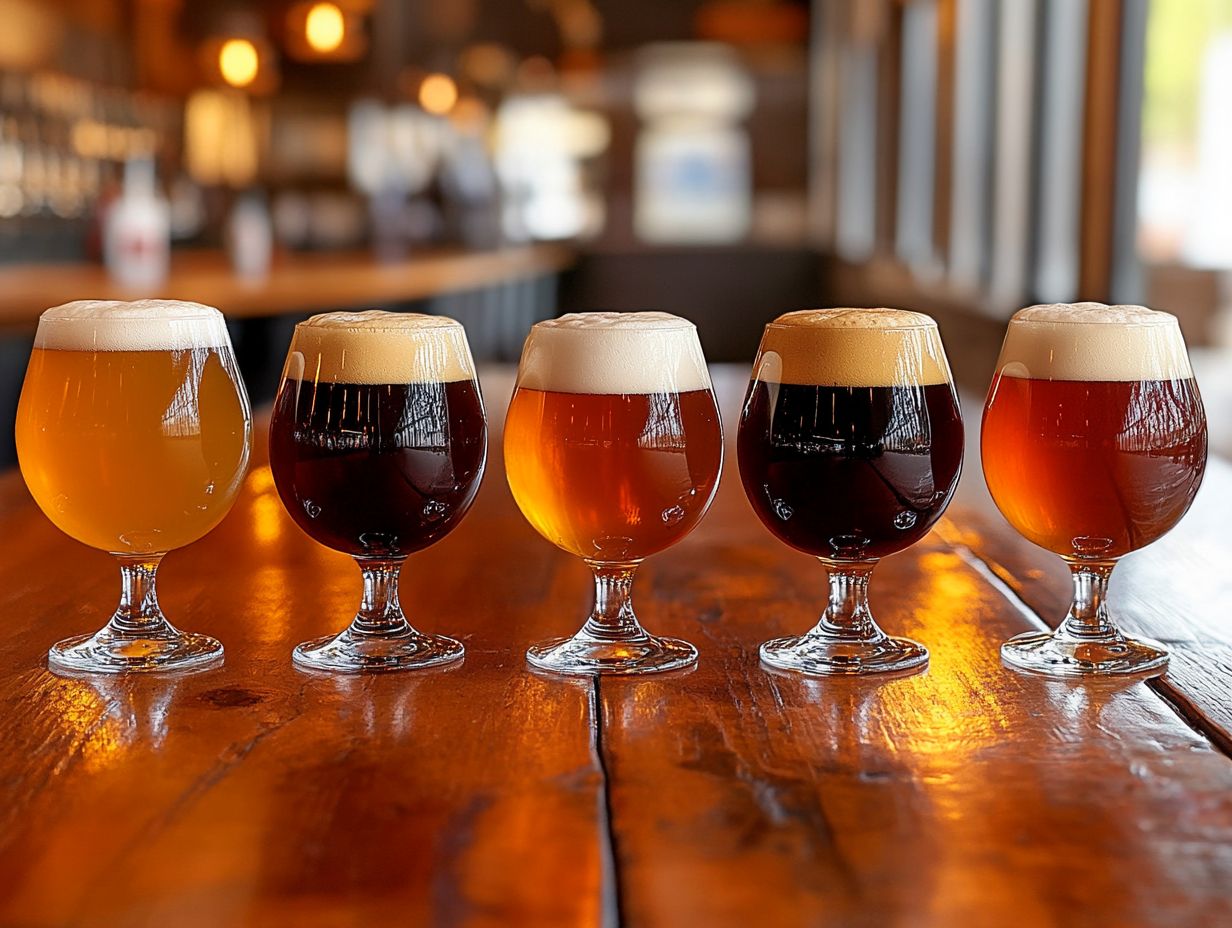
Key characteristics of unique beer styles such as Gose, Eisbock, and Rauchbier present a fascinating exploration into unique flavors, innovative brewing techniques, and regional influences. This enriches your craft beer experience. Each style offers its own attributes that define flavor, aroma, and mouthfeel. This ensures a diverse array of options for every discerning beer enthusiast.
Take Gose, for example. Its signature tartness paired with a subtle saltiness thanks to coriander and salt makes it a refreshing yet complex choice for those who appreciate a little zing in their beverage. Much like a wheat beer, it can be enjoyed for its light flavors.
On the flip side, Eisbock showcases robust maltiness with a higher alcohol content, a delightful consequence of its freeze distillation process. This style is often compared to other malty flavors found in a brown ale. It is perfect for those who crave intense flavors and a warming embrace in their beer.
Then there s Rauchbier, which beckons with its smoky aroma, reminiscent of cozy campfire nights. This style highlights hop bitterness, appreciated in hoppy pilsners. It appeals to those who have a fondness for traditional brewing methods steeped in history.
As the craft beer community continues to evolve, these distinctive styles resonate deeply, shining a light on the innovation and creativity that define this vibrant landscape.
How Can One Incorporate These Styles Into Their Beer Tasting Experience?
Incorporating unique beer styles like Sahti or Kentucky Common into your beer tasting experience opens the door to an exciting exploration of the rich tapestry of flavors and brewing traditions that craft beer has to offer. This includes styles such as India Pale Ale (IPA) and Belgian Wheat beers.
By curating a selection of distinct styles, you ll appreciate the nuances and complexities of each brew. This will undoubtedly enhance your overall tasting journey!
To truly elevate this experience, consider using appropriate glassware that complements each beer s aroma and flavor. For instance, tulip glasses are perfect for fruity ales, while snifters work wonders for robust stouts.
Pairing these beers with suitable foods can also elevate the tasting; imagine how a rich, malty Kentucky Common could harmonize beautifully with smoked meats or sharp cheeses.
Encourage everyone to jot down detailed notes on their impressions, from flavors to aromas, and spark a dialogue about their favorites. Consider discussing session beers and their impact on your overall tasting experience.
This shared experience will foster camaraderie and deepen your appreciation for the artistry behind different beer styles.
What Are the Origins of These Unique Beer Styles?
The origins of unique beer styles such as Bi re de Champagne and Rauchbier are intricately woven into their cultural and historical contexts. This demonstrates how traditional brewing practices have shaped the contemporary craft beer community.
One cannot overlook the influence of Michael Jackson, a beer enthusiast and writer who helped popularize many of these styles. As you delve into these origins, you’ll uncover fascinating stories behind each style, showcasing the evolution of beer as a reflection of regional flavors and innovative brewing techniques.
Take, for instance, Bi re de Champagne, which hails from the Champagne region of France. It sits alongside other notable styles such as Belgian-Style Gueuze Lambic and Berliner-Style Weisse. It highlights meticulous production methods that prioritize quality and tradition. Its sparkling characteristics capture the very essence of French craftsmanship.
On the other hand, there s Rauchbier, originating from Bamberg in Germany. This style offers a rich tasting experience, like many porter and stout varieties. It carries a rich history of smoking malt over open flames, imparting a unique flavor profile that distinctly sets it apart from other lagers.
These regional specialties not only emphasize the artisanal techniques employed by skilled brewers but also contribute to a vibrant tapestry of cultural heritage. This enriches the global craft beer landscape and has led to a surge in beer variety and beer trends worldwide. They inspire modern brewers to experiment while staying true to their roots.
Why Are These Styles Becoming More Popular in the Craft Beer Community?
The rising popularity of unique beer styles within the craft beer community speaks to a desire for diversity in flavors and experiences. As you explore the offerings of craft breweries, you’ll notice how these innovators experiment with traditional recipes and embrace cutting-edge brewing techniques. This exciting trend reflects a growing demand for local and artisanal production, inviting you to discover new styles that challenge conventional tastes.
As you seek more personalized and distinctive flavors, craft breweries have stepped up to meet this demand, incorporating local ingredients that showcase regional profiles. This is evident in the development of seasonal beers and unique flavors tailored to local tastes. The use of seasonal fruits, herbs, and even spices is now commonplace, allowing breweries to weave stories through their beers. Imagine savoring an IPA from a Pacific Northwest brewery, infused with fresh hops sourced from nearby farms a taste that s vibrant and entirely unique. The incorporation of local breweries in this process further enhances the authenticity of the experience.
Take note of community-focused breweries, like the acclaimed parish breweries in Louisiana, which have garnered attention for their adventurous brewing styles. They often experiment with different yeast strains and lagering processes to create their signature brews. These breweries emphasize collaboration with local farmers and artisans, curating flavors that resonate with discerning drinkers. This deeper connection enriches the drinking experience and cultivates a sense of community among those who value the craftsmanship behind each unique brew.
Frequently Asked Questions
What are the 7 craft beer styles that I didn’t know existed?
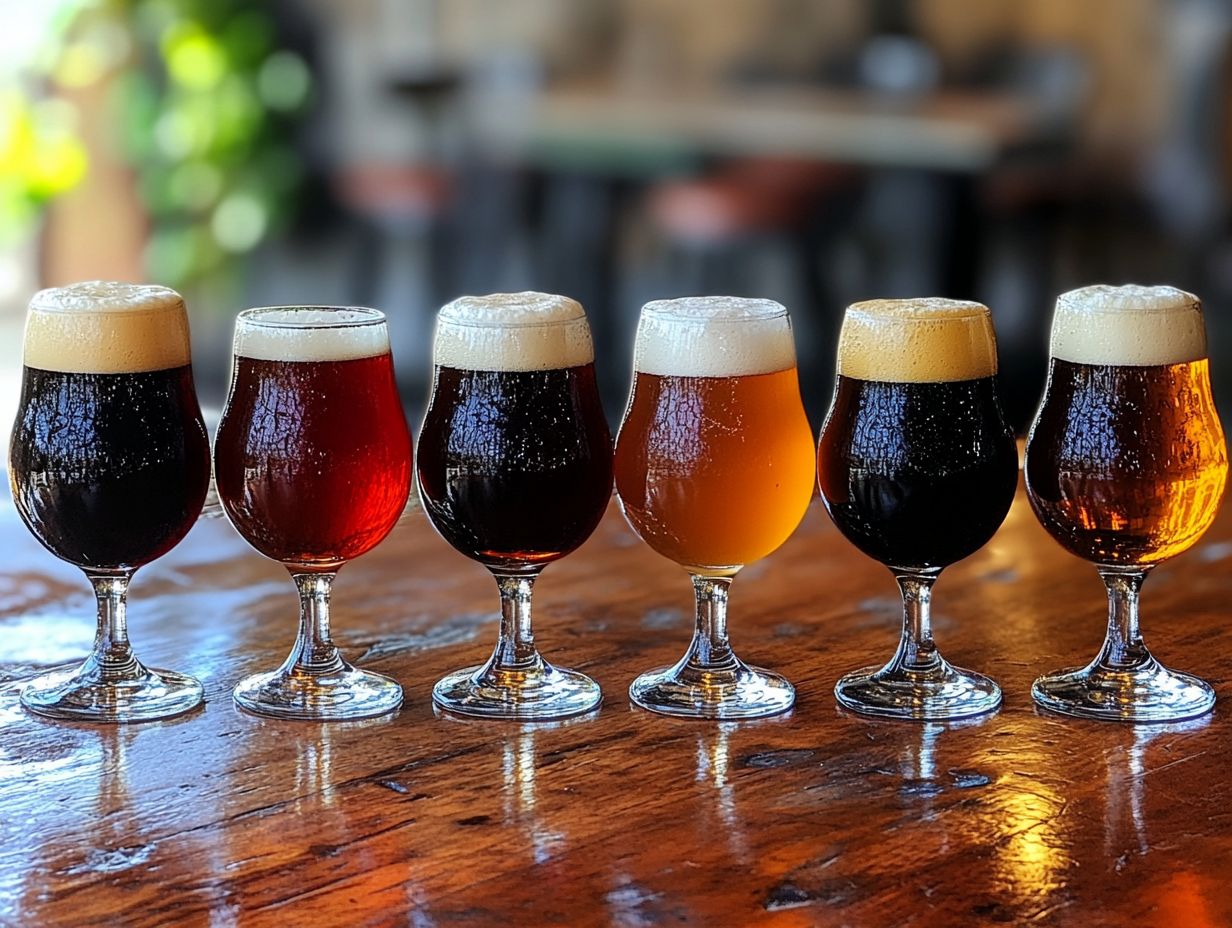
The 7 craft beer styles that you may not have heard of are Gose, Bi re de Garde, Rauchbier, Dampfbier, Kvass, Kolsch, and Lambic. These styles, alongside popular names like Guinness, Sierra Nevada, and Shock Top, offer a wide range of flavors to explore.
What is Gose and how is it different from other beers?
Gose is a tart and slightly salty German-style wheat beer made with coriander and salt, giving it a refreshing and slightly sour flavor. Much like Blue Moon or Budweiser, it has carved out its own niche in the market.
What is Bi re de Garde and where does it originate from?
Bi re de Garde is a traditional French farmhouse ale that originated in Northern France. It has a rich, malty flavor and is often compared to a Belgian Saison. This style shares some similarities with the well-known Newcastle Brown Ale.
What makes Rauchbier stand out among other beers?
Rauchbier, also known as smoked beer, is a German-style beer made using smoked malt. This process gives it a distinct smoky flavor that is often compared to bacon or a campfire. It stands out among classic beers like Miller High Life and Pilsner.
What is Dampfbier and what does it taste like?
Dampfbier is a Bavarian-style beer made from wheat, barley, and rye. It falls under traditional beer categories and has a cloudy appearance with a spicy, fruity flavor reminiscent of a Hefeweizen. Many beer drinkers appreciate its unique flavors, which align with various beer preferences.
What is Kvass and where is it popular?
Kvass is a traditional Russian and Eastern European beer-style beverage made from fermented rye bread. It is often described as tasting similar to a mix of beer and non-alcoholic root beer. This drink shows how diverse beer flavors can be.
What makes Kolsch and Lambic different from other beer styles and trends?
Kolsch is a light, crisp, and clear beer brewed in Cologne, Germany. It is a hybrid between an ale and a lager, giving it a unique flavor. In contrast, American lagers and hoppy pilsners are more commonly found in the craft beer community. Lambic, on the other hand, is a Belgian style of beer that is fermented with wild yeast and bacteria, giving it a distinct sour flavor. Belgian-style ales, such as Belgian-Style Gueuze Lambic, fall into this category, showcasing the diversity in beer styles.
We encourage you to share your craft beer experiences or explore new breweries in your area!



